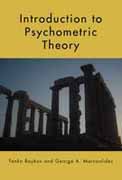
This new text provides a state-of the-art introduction to educational and psychological testing and measurement theory that reflects the many intellectual developments of the past two decades. The book introduces psychometric theory using a latent variable modeling (LVM) framework and emphasizes interval estimation throughout, so as to better prepare readers for studying more advanced topics later in their careers. Featuring numerous examples, it presents an applied approach to conducting testing and measurement in the behavioral, social, and educational sciences. Readers will find numerous tips on how to use test theory in today's actual testing situations. To reflect the growing use of statistical software in psychometrics, the authors introduce the use of Mplus after the first few chapters. SPSS, SAS, and R are also featured in several of thechapters. Software codes and associated outputs are reviewed throughout to enhance comprehension. All of the data and input and output files referred to inthe book are available on the website along with pertinent commands and otherfeatures. The authors rely on LVM when discussing fundamental concepts such as exploratory and confirmatory factor analysis, test theory, generalizability theory, reliability and validity, interval estimation, nonlinear factor analysis, generalized linear modeling, and item response theory. The varied applications make this book a valuable tool for those in the behavioral, social, educational, and biomedical disciplines, as well as in business, economics, and marketing. A brief introduction to R is provided in Section 2.8 and in the Appendix to Chapter 11. Intended as a text for advanced undergraduate and/or graduate courses in psychometrics, testing and measurement, measurement theory, psychological testing, and/or educational and/or psychological measurement taught in departments of psychology, education, human development, epidemiology, business, and marketing, this book is also expected to appeal to applied researchers in these disciplines. Prerequisites include an introduction to statistics with exposure to regression analysis and ANOVA. Familiarity with SPSS, SAS, STATA, or R is also beneficial. As a whole the book provides an invaluable introduction to measurement and test theory to those with limited or no familiarity with the mathematical and statistical procedures involved in measurement and testing. INDICE: 1. Measurement, Measuring Instruments, and Psychometric Theory. 2.Basic Statistical Concepts and Relationships. 3. An Introduction to Factor Analysis. 4. Introduction to Latent Variable Modeling and Confirmatory Factor Analysis. 5. Classical Test Theory. 6. Reliability. 7. Procedures for EstimatingReliability. 8. Validity. 9. Generalizability Theory. 10. Introduction to Item Response Theory. 11. Fundamentals and Models of Item Response Theory. Chapter Notes. Appendix. A Brief Introduction to Some Graphics Applications of R in Item Response Modeling.
- ISBN: 978-0-415-87822-7
- Editorial: Routledge
- Encuadernacion: Cartoné
- Páginas: 347
- Fecha Publicación: 01/10/2010
- Nº Volúmenes: 1
- Idioma: Inglés
